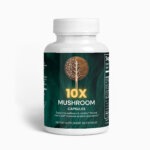
“Exploring Habitats: Where Lion’s Mane Mushrooms Grow”
Venture deep into the untamed, shadowy forests, where dappled sunlight peeks through thick canopies, and you might just stumble upon a surreal spectacle—the Lion’s Mane Mushroom. This culinary crown jewel, Hericium erinaceus by its scientific moniker, isn’t just a delight for foragers and gourmet chefs; it’s a treasure trove of medicinal marvels waiting to be discovered. With its cascading, icicle-like spines and an uncanny resemblance to the regal manes of lions, this magnificent fungus captivates the eye and piques the curiosity of anyone fortunate enough to cross its path.
But where do these ethereal entities make their secret abode? Whether you’re a budding naturalist eager to unearth the mysteries of fungal habitats or a connoisseur on a quest for the ultimate umami flavor, the journey to locate the Lion’s Mane Mushroom is an adventure in its own right—one that promises the thrill of exploration and the reward of discovery. So don your explorer’s hat and let us transport you to the enchanting world of Lion’s Mane Mushrooms, guiding you through the verdant forests and misty woodlands they call home. Prepare to be persuaded, as we unveil the majestic settings where these fungi flourish—a narrative that weaves together nature’s intricate tapestry and the beguiling charm of the wild.
Table of Contents
- Unveiling the Mystique of Lion’s Mane Habitats
- Decoding the Preferred Climate for Lion’s Mane Proliferation
- The Secret Hideouts: Understanding Lion’s Mane Ecosystems
- From Forest Floors to Fallen Logs: Tracing the Lion’s Mane Trail
- The Symphony of Symbiosis: Lion’s Mane and Their Host Trees
- Foraging with Finesse: Tips for Locating Lion’s Mane Mushrooms
- Cultivating Your Own Lion’s Den: Growing Lion’s Mane at Home
- Preserving the Pride: Conservation Efforts for Wild Lion’s Mane Habitats
- Q&A
- Final Thoughts
Unveiling the Mystique of Lion’s Mane Habitats

Deep within the lush, thriving woods, veiled by the heavy mists of early dawn, a remarkable organism patiently emerges from the rich, decayed matter of fallen trees. The Lion’s Mane mushroom, with its soft, cascading spines, resembling a miniature waterfall of ivory, chooses these hidden, serene havens as its playground. Favored by the forest’s dappled light, this culinary and medicinal marvel thrives where the air is moist and the ecosystem buzzes with life.
Forests with a plethora of hardwoods are akin to luxury estates for these shaggy fungi. Their presence is often noted in North American temperate forests, spreading their mycelial networks through the heartwood of particularly oak, beech, birch, and maple trees. As decomposers, Lion’s Mane mushrooms act as nature’s recycling agents, breaking down the tough lignin and transforming the substrate into a fertile bed for new growth.
- Temperate Broadleaf Deciduous Forests
- Aged, Mature Hardwood Trees
- Forgotten Woody Debris and Fallen Trees
- Locations with High Humidity and Fairly Cool Temperatures
In the right conditions, these mushrooms don’t limit themselves to forested seclusion. Adventurous strains find sanctuary on stray logs nestled in shaded areas of gardens or peeking out from the bases of dead or dying trees in suburban landscapes. Gardens that mimic the moist, stable environments of natural forests can inadvertently become micro-habitats, fostering the growth of these delectable, brain-boosting fungi.
Let’s take a quick glance at the prime real estate of Lion’s Mane mushrooms:
| Region | Typical Habitat Features | Common Tree Hosts |
|---|---|---|
| North America | Old-growth forests, high humidity | Oak, Maple |
| Europe | Temperate woodlands, cool climates | Beech, Birch |
| Asia | Mountainous regions, moist conditions | Broadleaf varieties |
Primarily, the preservation of these habitats is imperative not only for the sustenance of Lion’s Mane ecosystems but also for the biodiversity they uphold. As advocates for nature’s splendor and the enchanting world of fungi, one could promote sustainable forestry practices and the conservation of old-growth forests. Let’s champion the cause to maintain these mystical environs where the fabled Lion’s Mane can continue to weave its ancient, beneficial threads through the tapestry of life.
Decoding the Preferred Climate for Lion’s Mane Proliferation

Embarking on a journey to uncover the secrets behind the remarkable growth of Lion’s Mane mushrooms is like delving into a botanical mystery. These unique fungi favor environments that mimic the forested sanctuaries of their ancestral home. Humidity, a key ingredient in this tale, envelops the Lion’s Mane in a gentle, moisture-laden embrace, essential for its delicate mycelium to thrive. The idyllic range? A consistent 85-95% humidity, acting as the catalyst for their impressive yields.
Imagine walking through a dense, ancient woodland; this is the canvas on which the Lion’s Mane masterpiece is painted. Temperature plays the artist, drawing its life cycle with a subtle palette. Cooler climates, with temperature ranges of 15-24°C (60-75°F), are preferred; here, the Lion’s Mane can unfurl its tendrils slowly, ensuring a form as perfect as nature intended. In these conditions, the fungi flourish, escaping the wrath of both the winter’s chill and the summer’s scorch.
- Altitude: Not one to shy from heights, this mushroom finds solace in elevated areas. The air, free from the clutches of pollution, enriches each spore.
- Substrate Preferences: From the nourishing fibers of hardwood trees to the welcoming decay of fallen timber, the Lion’s Mane is not a fussy eater. Yet, it shows a fondness for the likes of oak, beech, and walnut, feasting on the bountiful lignin within.
Their habitat’s delicate nuances are echoed in a hand-crafted table, which captures the essence of these ethereal conditions:
| Condition | Preferred Range |
|---|---|
| Humidity | 85-95% |
| Temperature | 15-24°C (60-75°F) |
| Altitude | Varied, higher preferred |
| Substrate | Hardwoods (e.g., oak, beech, walnut) |
Indeed, unlocking the secret to the Lion’s Mane’s preferred climate is akin to mastering the art of mushroom cultivation itself. It beckons the enthusiast to respect these conditions, forging a path that leads to sustainable growth and an enduring admiration for these forest-dwelling treasures.
The Secret Hideouts: Understanding Lion’s Mane Ecosystems

Nestled in the fabled forests of the Northern Hemisphere, amidst decaying logs and rich humus soil, the Lion’s Mane mushroom flourishes. This ethereal fungus, with its cascading white spines resembling a regal mane, is as enchanting as it is elusive. The forest’s ancient arbors serve as both guardian and nurturer to these majestic organisms, offering a microhabitat that is as complex as it is crucial for their growth.
In the shadowy embrace of the hardwood trees, particularly oaks and maples, the Lion’s Mane finds the perfect cradle for its development. The interplay of shade and sunlight filtering through the leafy canopies crafts a delicate dance of dappled light – a spectacle that not only captivates the observer but also creates the ideal level of indirect lighting these mushrooms require.
Key Elements of Lion’s Mane Habitats:
- Decayed and fallen hardwood timber
- High humidity paired with moderate temperatures
- A balance of shaded and dappled sunlight areas
- Nutrient-rich soil with ample organic matter
Underpinned by these environmental symphonies are the life-giving waters that sustain the Lion’s Mane. The moist atmosphere of its preferred woodland locales is not by accident but by the lifeblood of nearby streams and rivers. The hydration provided plays a vital role in mushroom formation, offering just enough moisture to fuel their growth without overwhelming these delicate fruiting bodies.
| Season | Availability | Temperature Range |
|---|---|---|
| Fall | High | 15°C – 24°C |
| Spring | Moderate | 4°C – 15°C |
| Summer | Low | 24°C – 30°C (less common) |
To the untrained eye, the Lion’s Mane may seem like a whimsical creation of nature, a woodland curiosity perched effortlessly upon its arboreal throne. However, to those aware of the intricate necessities of its habitat, it is a reminder of nature’s fragile complexities. It’s an invitation to marvel at and protect the ecosystems that cradle these mystical mushrooms, lest they retreat forever into the annals of hidden natural treasures.
From Forest Floors to Fallen Logs: Tracing the Lion’s Mane Trail

Imagine wandering through a dense forest, the air rich with the scent of earth and moss. Beneath the towering trees lies a woody treasure trove, one that boasts cascading white icicles that are pleasing not just to the eye, but also to the palate and health. The Lion’s Mane mushroom, a cognitive enhancer, and an immune booster, thrives in these lush environments, proudly displaying its shaggy mane on the trunks of age-old trees and fallen logs.
These fungal delights are not just any random forest inhabitants. They’re selective, choosing their homes with the utmost care. Typically, they’re found embracing hardwoods like oak, beech, walnut, and maple. But it’s not just any spot on these trees that will do. The mushrooms favor the wounds of the tree, areas where the bark has been compromised and the inner wood exposed, giving them just the right environment to flourish.
- Secluded hardwood forests
- Decaying trunks and branches
- Natural wooden wounds
- Shady, moist areas
The lifecycle of these mushrooms can almost be read like a story, a tale of resilience and adaptability. When a great tree falls, it might seem like the end, but for the Lion’s Mane, it is merely the beginning of a new chapter. The once towering giants become nourishing hotspots for fungi, providing the perfect mix of nutrients and shelter. It’s a circle of life where the end gives birth to a beginning rich with fungal life.
In our quest for these gourmet fungi, one must pay homage to the delicate balance they require to thrive. The table below highlights the essential conditions conducive to the growth of these natural marvels:
| Condition | Importance |
|---|---|
| Temperature | Prefer cooler climates, usually found in fall to early spring |
| Substrate | Hardwood logs and trees with exposed inner wood layers |
| Moisture | Moist but not waterlogged environments |
| Decomposition Stage | Partially decomposed wood is ideal |
Embrace the forest adventure, seek out these magnificent mushrooms, and appreciate the unique and hidden nooks of the wild that they call home. In doing so, not only do we find a gateway to enrichment through foraging but also a deeper understanding of the delicate interconnections within nature’s tapestry.
The Symphony of Symbiosis: Lion’s Mane and Their Host Trees

In the intricate dance of nature, the illustrious Lion’s Mane mushroom (Hericium erinaceus) forges a delicate yet crucial alliance with its arboreal partners. This remarkable fungi finds sanctuary within the sheltering arms of hardwood sentinels, thriving on their venerable trunks. Oftentimes, aged or wounded trees serve as nurturing hotbeds for these impressive fungi, with their intricate, cascading spines akin to a waterfall of white.
As a testament to this alliance, Lion’s Mane mushrooms contribute to the health of their host trees through a remarkable process known as biodegradation. This harmonious interaction breaks down the tough, woody fibers of the tree, recycling nutrients back into the ecosystem. The fungi’s role is indeed a celebration of life, as it gently ushers its partner from one phase of existence to another, ensuring that what once was a towering giant may continue to nourish the forest in a new form.
The favored hosts of the Lion’s Mane often include:
- Beachwood: Bestowing a delicate, slightly sweet undertone to the mushroom’s flavor.
- Oak: Offering its stalwart strength as a foundation for growth.
- Maple: Infusing the fungi with the subtlest hint of its saccharine essence.
- Walnut: Providing a rich, robust canvas upon which Lion’s Mane may adorn.
Discovering a Lion’s Mane mushroom in its natural habitat is akin to chancing upon a forest jewel. The sight of this living chandelier is as enchanting as it is rare, a clear indicator of the majestic complexity that lies within the woodland tableau. While it signifies an end for the tree that supports it, Lion’s Mane also symbolizes an enduring legacy, a continual cycle of giving that is the very essence of the woodlands’ symphonic life.
Foraging with Finesse: Tips for Locating Lion’s Mane Mushrooms

Embarking on a mushroom foray is an enchanting and rewarding experience, especially when the elusive Lion’s Mane mushroom is the treasure you seek. This bearded beauty, with its cascading spines resembling a waterfall of white threads, thrives in a setting quite particular to its nature. To spot the Lion’s Mane, you’ll need a keen eye and a dose of patience, as it often favors the solace of aged hardwoods. Begin your search in the late summer through fall, as these seasons provide the perfect concert of conditions for their fruiting.
When setting off into the wooded whispers of nature, your senses must be in harmony with the forest’s subtle cues. Keep this checklist in your forager’s kit:
- Deciduous Delight: Focus on where hardwood trees like oak, beech, or maple stand tall; these are the preferred hosts for these ethereal fungi.
- Tree Trauma: Peer into areas where trees have surrendered to age or injury because these mushrooms often emerge from the wounds of living and dead woods.
- Guarded Glades: Explore hidden clearings and forest edges where direct sunlight dapples the ground – not too much, lest the delicate mycelium shy away.
Maintain a gentle footprint as you wander through nature’s patchwork, allowing the forest to remain as undisturbed as possible. Remember, what sustains the Lion’s Mane also sustains a cornucopia of other woodland inhabitants. To respect the circle of life is to guarantee the thrill of future hunts.
| Environment | Descriptors |
|---|---|
| Old-Growth Woods | Time-worn, vast, a treasure trove of biodiversity |
| Wounded Woodlands | Rich in organic matter from split bark and decaying logs |
| Subdued Sunlight | Filtered light, morning rays, twilight gleam |
Learn to move with the quiet confidence of a seasoned forager. The allure of the Lion’s Mane is not only in its medicinal prowess or its divine, crab-like flavor but also in the pursuit itself. Tread lightly, look deeply, and let the wilderness whisper its secrets to you. Each successful foray furthers the dance between human and habitat, a dance of discovery and respect.
Cultivating Your Own Lion’s Den: Growing Lion’s Mane at Home

If you find the allure of cultivating your own gourmet mushrooms irresistible, the lion’s mane mushroom (Hericium erinaceus) might just be your perfect starting point. These shaggy, white fungi not only offer a unique visually enticing aspect to your kitchen garden but are also revered for their potential health benefits. Imagine the satisfaction as you watch these beautiful specimens emerge, knowing they are a result of your nurturing care.
To mimic the natural abode of these forest dwellers, begin with the right substrate. Lion’s mane mushrooms have a particular affinity for hardwood sawdust mixed with a bit of bran.
- Oak
- Maple
are superb choices that emulate the trees these mushrooms would typically colonize in the wild. A carefully controlled environment ensures your indoor lions will thrive – seek a spot in your home that stays humid, and where temperatures are steady, between 65°F to 75°F (18°C to 24°C).
As for the real spice of growing lion’s mane: patience and observation. Each stage, from the inoculation of spores until the first heady flush of growth, is an opportunity to deepen your understanding of your mushroom culture. Regular checks on moisture levels and signs of contamination will teach you how to create ideal growing conditions to ensure a bountiful harvest. Here’s where the bond between gardener and fungus takes on a personal touch, as intuition and care mix with a bit of science.
When the time comes to harvest, you’ll know it - those cascading spines will have reached their peak size, feeling supple to the touch. At this stage, your cultivated delights are ready to be gently plucked from their block. But don’t just stop there; incorporate them into your cooking and experience the fruits of your labor. Whether sautéed, baked, or used as a meat substitute, the lion’s mane offers a delicate, seafood-like flavor that is sure to impress any palate.
Preserving the Pride: Conservation Efforts for Wild Lion’s Mane Habitats

The wild, undisturbed forests and the decaying hardwood upon which the Lion’s Mane mushroom thrives are more than just a place for growth—they represent an intricate ecosystem essential to its survival. The preservation of these mystical habitats is much like the nurturing of a delicate heirloom, passed down through ecological generations. To ensure the continuance of Hericeum erinaceus in its natural state, sustained conservation efforts are more pivotal than ever.
The symbiotic relationship between the Lion’s Mane and the ancient forests is profound. The mushroom’s preference for wounded soldiers of the forest—fallen trees and stumps—shows its integral role in the circle of forest life. This adds another layer to conservation—it isn’t just about saving the living trees, but also respecting the fallen. Biodiversity is the clarion call to action here, emphasizing not only the maintenance of living trees but the deadwood that is critical for fungal prosperity.
- Monitor and protect old-growth forests
- Limit deforestation impacts
- Encourage sustainable foraging practices
- Expand scientific research for habitat understanding
Unregulated harvesting and climate change complicate their existence, calling for measures that include but are not limited to community-led conservation initiatives. Involved parties range from local enthusiasts to mycologists, all united under the cause of habitat preservation. The efforts blanket numerous tactics, such as creating awareness among the foraging community to selectively harvest, allowing the mushrooms the chance to disperse spores for future growth.
| Conservation Focus | Action Items |
| Protection | Legal measures to safeguard habitats |
| Education | Workshops for foragers and local communities |
| Research | Fund and disseminate new studies |
In conclusion, the wild realms that are home to the majestic Lion’s Mane mushroom call for our attention and respect. By fostering environmental stewardship, advocating for smart conservation strategies, and genuinely investing in the health of our forests, we can preserve the pride and the legacy of this extraordinary ecosystem.
Q&A
### Exploring Habitats: Where Lion’s Mane Mushrooms Grow
**Q: Can you unveil where the mighty Lion’s Mane mushroom thrives in the wild?**
A: Picture this – ancient, towering hardwood forests casting dappled light onto a richly embroidered forest floor. This is the realm where the Lion’s Mane mushroom reigns supreme. Often nestled in the scarred wounds of fallen logs or clinging to the majestic trunks of living trees, this shaggy wonder prefers the company of beech, oak, and maple. It’s here, in the nourishing cradle of these deciduous giants, that the Lion’s Mane mushroom flourishes, turning these serene groves into a forager’s treasure trove.
**Q: Does the Lion’s Mane mushroom have a preferred climate, or is it a versatile traveler?**
A: Much like a seasoned globetrotter who knows just what to pack for any trip, the Lion’s Mane mushroom displays a wide-ranging adaptability. Although it does have a penchant for the temperate forests of North America, Europe, and Asia, don’t be surprised to find it on a sojourn in subtler climates. The key to its heart? A climate festooned with cool, moist, and fresh air – the perfect recipe for this fungi’s growth and prosperity.
**Q: Could I be lucky enough to spot a Lion’s Mane mushroom in my city park or nearby woods?**
A: The odds could be in your favor! While it’s true that the Lion’s Mane prefers the quietude of more secluded woodlands, urban foragers can sometimes spot these charismatic fungi adorning hardwood stumps or trees in well-maintained city parks, particularly those with old-growth trees. Keep your eyes peeled on your next stroll – urban nature often hides unexpected wonders right under our noses.
**Q: Is cultivating the Lion’s Mane mushroom at home a fanciful dream or a feasible reality?**
A: Dream no more, for this is a delightful possibility! While there’s a certain thrill in encountering Lion’s Mane mushrooms in their natural habitat, growing your own can be equally enchanting. With mushroom grow kits and the right environmental conditions, you can cultivate these majestic fungi in the comfort of your own home. Imagine having a mini-forest of Lion’s Mane at your fingertips – it’s an ethical, sustainable, and deeply rewarding way to enjoy these magnificent mushrooms.
**Q: What makes the Lion’s Mane mushroom habitat so vital to its existence?**
A: The habitat of the Lion’s Mane is not merely a home but a sanctuary that provides everything it needs to thrive: the right wood for nutrition, the shade to protect from drying out, and the high humidity to keep its growth steady and fruitful. Protecting these habitats is crucial not only for the survival of the Lion’s Mane but for the intricate tapestry of the forest ecosystem that relies on this unique organism for balance and biodiversity.
So there you have it, fellow fungi enthusiast – by protecting the habitats in which the Lion’s Mane mushroom flourishes, you become a guardian of these natural wonders. Venture forth responsibly, and let the enchantment of the forest guide you to these delightfully shaggy treasures.
Final Thoughts
As we’ve roamed the forested realms where the mystical lion’s mane mushroom emerges, embracing the dance between life and decay, we’ve come to understand that these living tapestries are more than just a backdrop for a fungus. They are intricate worlds teeming with secrets awaiting our discovery, guardians of a wonder that offers both sustenance and wisdom.
You, too, can become an explorer of these wild domains. With the knowledge you’ve gleaned today, the trees around you whisper invitations to step into their shadowy embrace, to seek out the elusive lion’s mane, and to forge a connection with the natural world that many have lost.
Venture forth with respect for the delicate balance that nature maintains, and remember that each mushroom you encounter is a testament to the resilience and intricacy of our ecosystem. Perhaps, in your quest for the lion’s mane, you’ll find more than a treasure trove of health benefits; you might discover a deeper kinship with the earth beneath your feet and the life it cradles.
So I urge you, fellow foragers and curious souls, to keep your senses sharp and your hearts open. Whether you find the lion’s mane mushroom clinging to a venerable hardwood or gracing your path unexpectedly, let the pursuit inspire your next adventure into the wild. And when you do kneel to witness its grandeur, remember that you’re not just looking at a mushroom—you’re peering into a world where nature’s majesty reigns supreme.

























